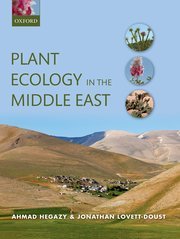Description
Plant Ecology in the Middle East
Authors: Hegazy Ahmad, Lovett-Doust Jonathan
Language: English
Subjects for Plant Ecology in the Middle East:
78.52 €
In Print (Delivery period: 21 days).
Add to cart
Publication date: 01-2016
368 p. · 19.6x24.8 cm · Hardback
368 p. · 19.6x24.8 cm · Hardback
Description
/li>Contents
/li>Biography
/li>
This advanced textbook explores the intriguing flora and plant ecology of the Middle East, framed by a changing desert landscape, global climate change, and the arc of human history. This vast region has been largely under-recognized, under-studied, and certainly under-published, due in part to the challenges posed to research by political disputes and human conflict, and a treatise on the subject is now timely. The book integrates Middle Eastern plant geography and its major drivers (geo-tectonics, seed and fruit dispersal, plant functional types, etc.) with the principles of plant ecology. The authors include the many specialized adaptations to desert and dryland ecosystems including succulence, water-conserving photosynthesis, and a remarkable range of other life history strategies. They explore the formation of 'climate relicts', and describe the long history of domestication in the region together with the many reciprocal effects of agriculture on plant ecology. The book concludes by discussing conservation in the region, highlighting five regional biodiversity hotspots where the challenges of desertification, habitat loss, and other threats to plant biodiversity are particularly acute. Plant Ecology in the Middle East is a timely synthesis of the field, setting a new baseline for future research. It will be important reading for both undergraduate and graduate students taking courses in plant ecology, evolution, systematics, biodiversity, and conservation, and will also be of interest and use to a professional audience of botanists, conservation biologists, and practitioners working in dryland ecosystems.
- 1: 'Drylandia' and the Dawn of Time: Introduction to Plant Ecology in
the Middle East
- 2: The Lay of the Land: Plant Geography in the Middle East
- 3: Continents in Motion and Global Climate Change: Understanding Past and Present Plant Communities
- 4: The Desert as a Heterogeneous Environment
- 5: Growing Up Dry
- 6: Sex in a Hot Dry Place
- 7: Seed Dispersal, Dormancy, and 'Bet-hedging' in Desert Plants
- 8: Chemical Ecology in the Desert
- 9: Agriculture and Plant Ecology
- 10: Human Impacts and Plant Conservation
- 11: Conclusions
- 2: The Lay of the Land: Plant Geography in the Middle East
- 3: Continents in Motion and Global Climate Change: Understanding Past and Present Plant Communities
- 4: The Desert as a Heterogeneous Environment
- 5: Growing Up Dry
- 6: Sex in a Hot Dry Place
- 7: Seed Dispersal, Dormancy, and 'Bet-hedging' in Desert Plants
- 8: Chemical Ecology in the Desert
- 9: Agriculture and Plant Ecology
- 10: Human Impacts and Plant Conservation
- 11: Conclusions
Ahmad Hegazy: Graduate of Cairo University (B.Sc. and M.Sc.) and University of Alberta, Canada (Ph.D.). Presently Professor at Cairo University (Applied Plant Ecology and Environmental Science). Supervision of over 45 Ph.D. and M.Sc. students. Research in population and community ecology of desert, coastal and mountain ecosystems; biodiversity, conservation ecology and management of protected areas; biological interactions; allelopathy; environmental pollution, phyto-remediation, restoration ecology; and environmental impact assessment. Published over 150 scientific papers, edited and co-authored several books. Implemented research programs in Egypt, Libya, Sudan, Qatar and Saudi Arabia. Participated in many international conferences. English-Arabic translation of environmental articles for Scientific American. Jon Lovett-Doust: B. Sc. (Hons. Biol.) from Queen's University, Kingston, Canada, and Ph.D. from University of Wales. Presently emeritus at University of Windsor. Research in macro-ecology, plant population biology and reproductive ecology. Carried out research in Egypt and elsewhere. Published over 100 scientific papers; co-authored and co-edited several other books.
© 2024 LAVOISIER S.A.S.




